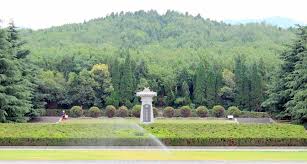
Is the Mausoleum of Qin Shi Huang Real?
The Mausoleum of Qin Shi Huang, a monumental testament to ancient Chinese engineering and imperial ambition, has captivated historians, archaeologists, and the world alike. While the mysteries surrounding its unexplored chambers continue to fuel speculation, the existence of the mausoleum itself is not in question. Here's why:
The Historical Record: A Testament in Stone and Ink
Constructed between 246 and 208 BCE, the mausoleum's creation is meticulously documented in historical records, most notably Sima Qian's "Records of the Grand Historian." This historical account, penned a century after the mausoleum's completion, provides detailed descriptions of the construction process, the treasures it holds, and the efforts taken to safeguard its secrets. The consistency between historical accounts and what archaeological surveys have revealed lends undeniable credence to the mausoleum's existence.
A Colossal Footprint: The Unmistakable Mark of Imperial Grandeur
The sheer scale of the Mausoleum of Qin Shi Huang is impossible to ignore. Its visible features, above ground, include:
- A Towering Tomb Mound: Reaching a height of 76 meters (approximately 250 feet), the tomb mound, visible from afar, stands as a testament to the manpower and resources dedicated to its construction.
- A City Mirrored: The mausoleum complex, planned as a microcosm of the Qin capital Xianyang, covers a vast area, encompassing both inner and outer city walls. The inner city, with a perimeter of 2.5 kilometers, housed the emperor's tomb and other significant structures. The outer city, stretching over 6.3 kilometers, likely accommodated administrative buildings, workshops, and the tombs of imperial family members.
Guardians of the Afterlife: The Terracotta Army
While the tomb itself remains unexcavated, the discovery of the Terracotta Army in 1974 provided undeniable proof of the mausoleum's existence. This army of life-sized terracotta soldiers, each with unique features, was intended to protect Qin Shi Huang in the afterlife. The sheer scale and sophistication of this find confirm the historical accounts of the mausoleum's grandeur and purpose.
Modern Technology: Peering Beneath the Surface
Archaeologists have used a range of non-invasive techniques, including:
- Remote Sensing: Techniques such as ground-penetrating radar (GPR) and magnetometry help create images of what lies beneath the surface, revealing the layout of tombs and other structures without disturbing the site.
- Chemical Analysis: Analysis of the soil and materials found around the mausoleum provides insights into the construction methods used and the potential presence of buried artifacts.
These methods, while they respect the sanctity of the site by avoiding excavation of the main tomb, provide further evidence of the mausoleum's existence and the vastness of its underground complex.
FAQs: Unveiling the Enigma
1. Why hasn't the tomb of Qin Shi Huang been excavated?
The Chinese government has chosen to delay excavation out of respect for the emperor and concerns about preserving the artifacts within. The technology to safely excavate and preserve the delicate treasures within such an old and complex tomb is still under development.
2. What treasures are believed to be inside the mausoleum?
Historical texts describe a cosmos recreated within, with ceilings depicting celestial bodies and flowing mercury symbolizing rivers and seas. Priceless artifacts, weapons, jade, and silk are also believed to lie within, offering a snapshot of Qin dynasty opulence.
3. What is the significance of the Mausoleum of Qin Shi Huang?
The mausoleum stands as a UNESCO World Heritage Site, not only for its historical significance as the final resting place of China's first emperor but also as a masterpiece of ancient engineering and a repository of invaluable information about the Qin dynasty.
The Mausoleum of Qin Shi Huang, though its secrets remain largely hidden, stands as an undeniable testament to the power and ambition of China's first emperor. Its existence is confirmed through historical records, archaeological findings, and modern scientific analysis, solidifying its place as one of the most intriguing and significant archaeological sites in the world.